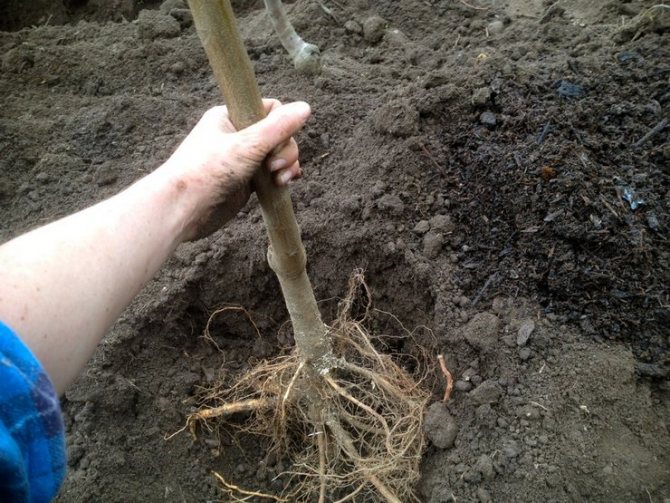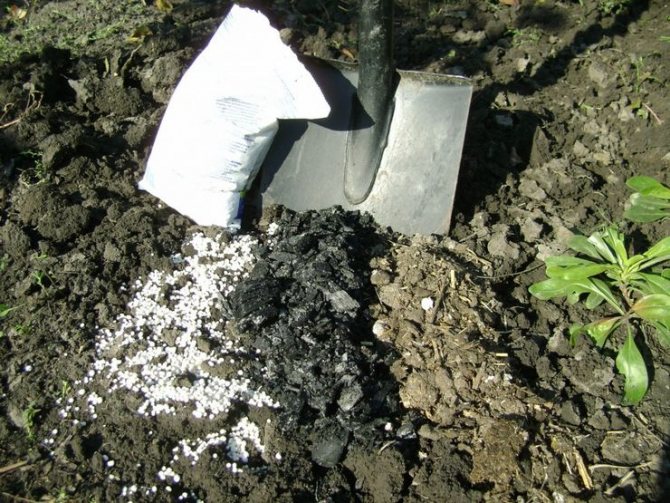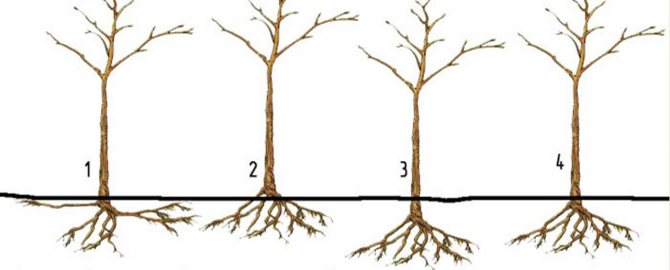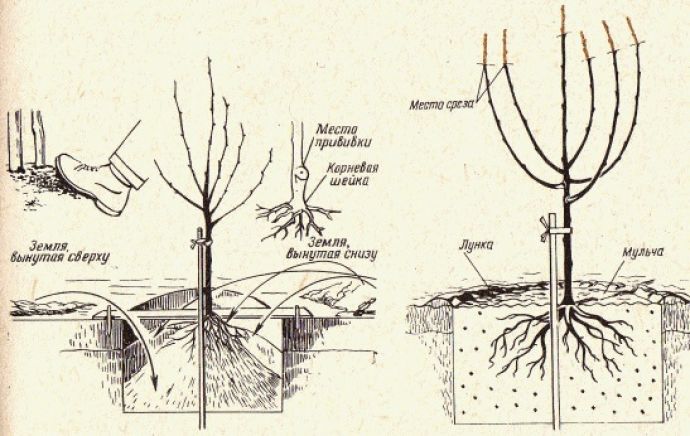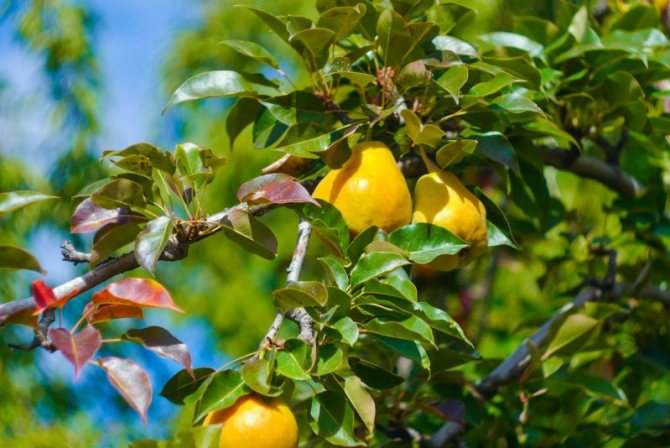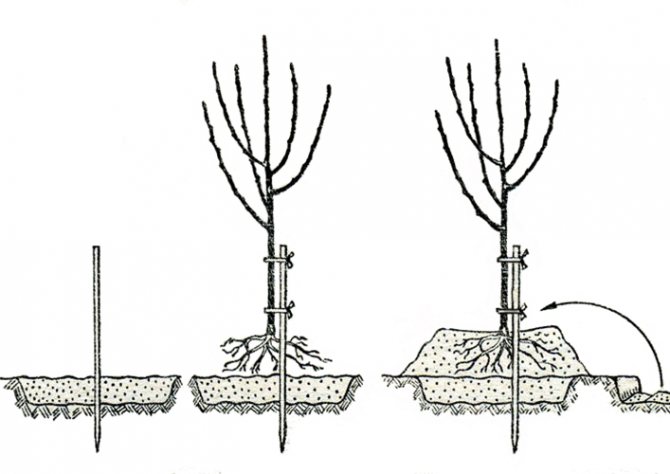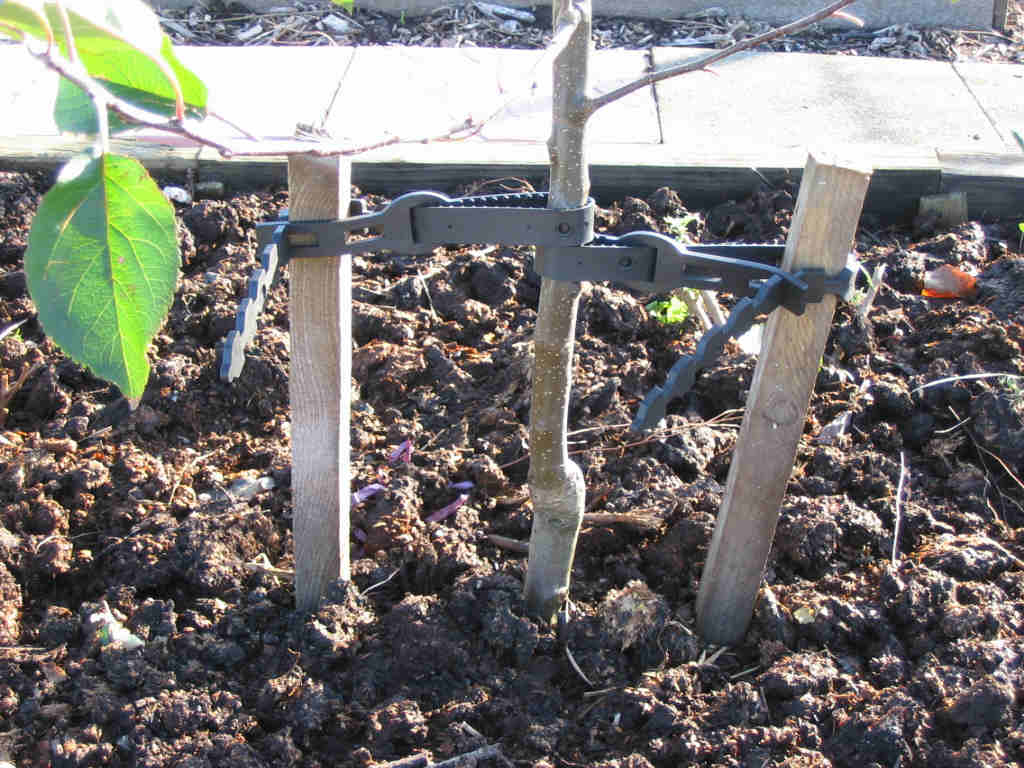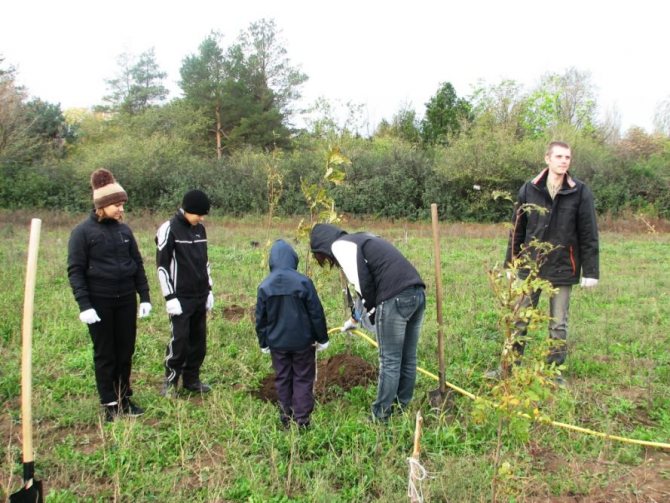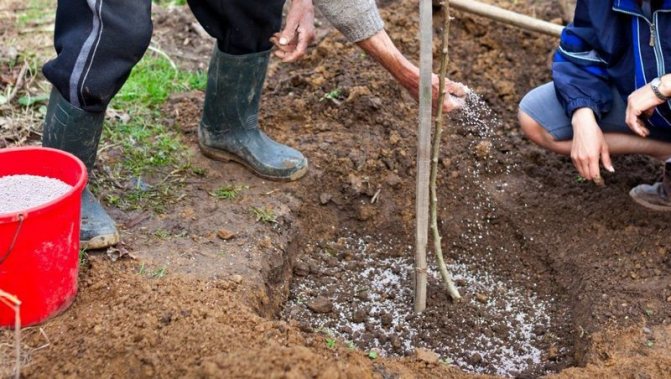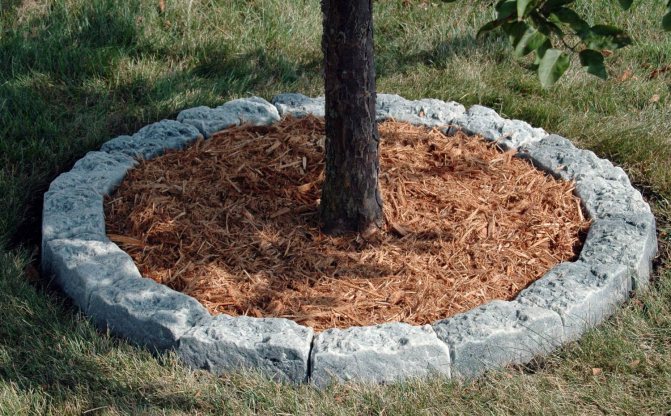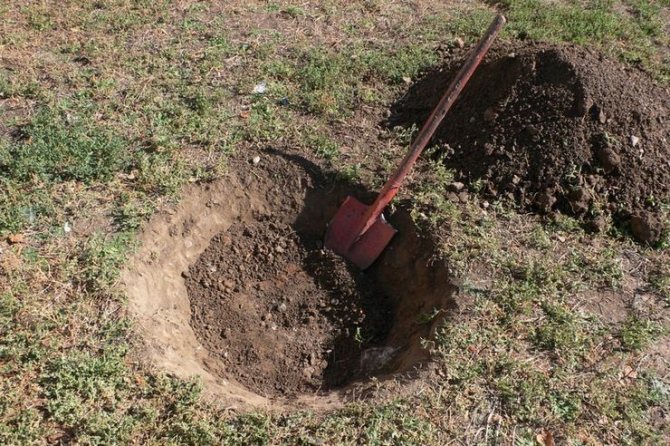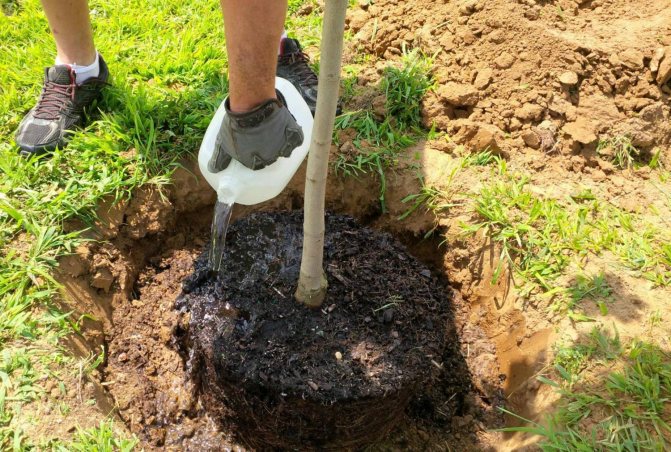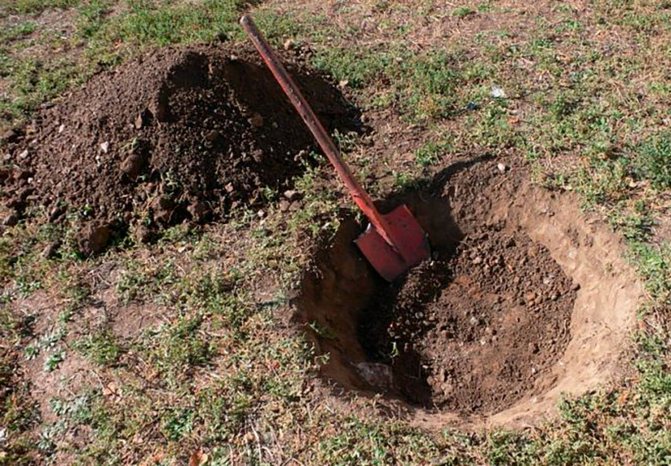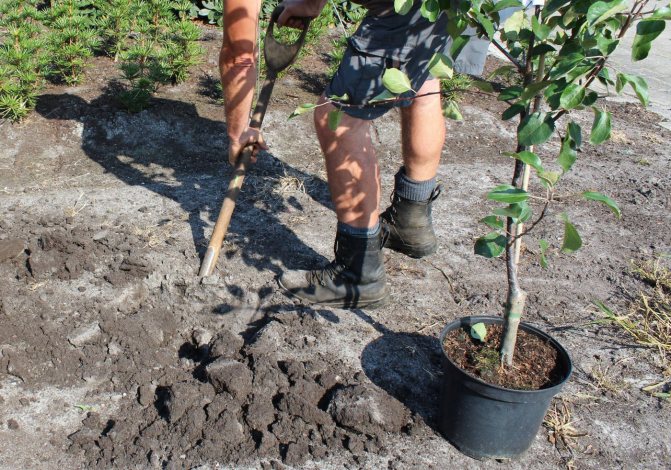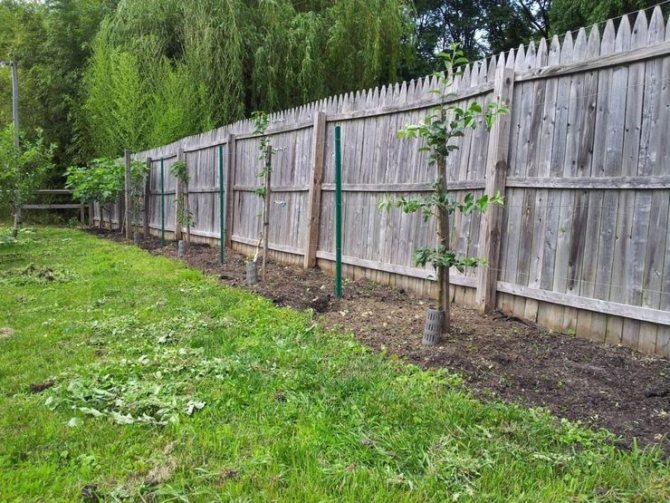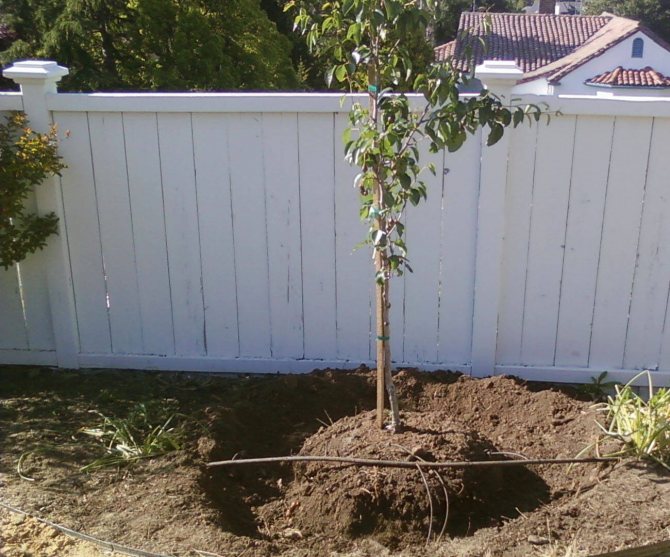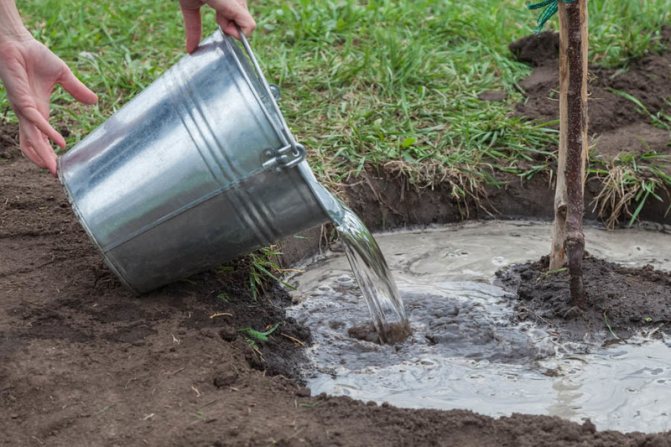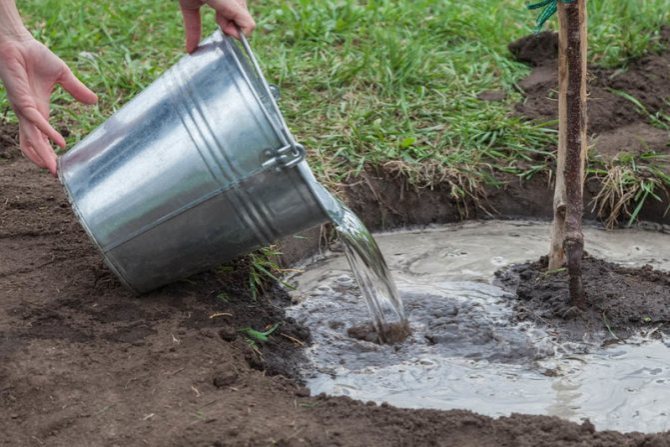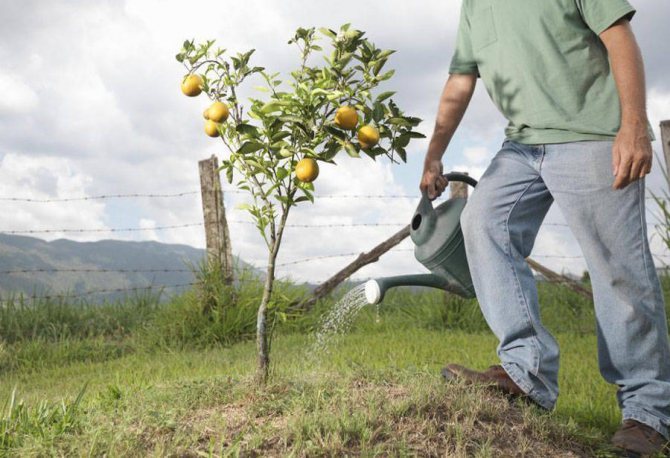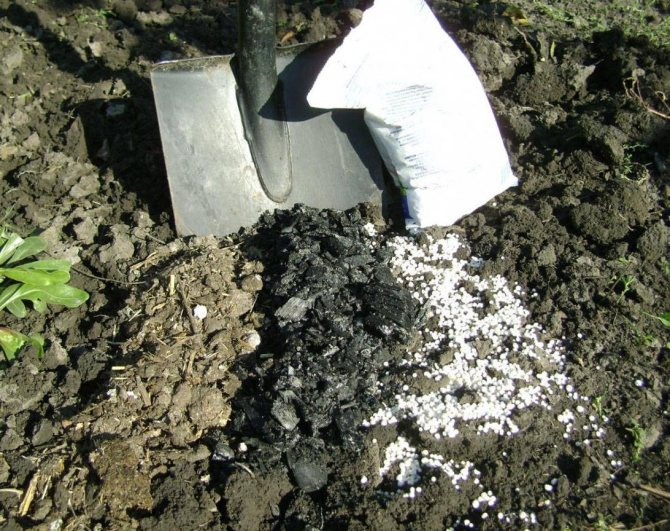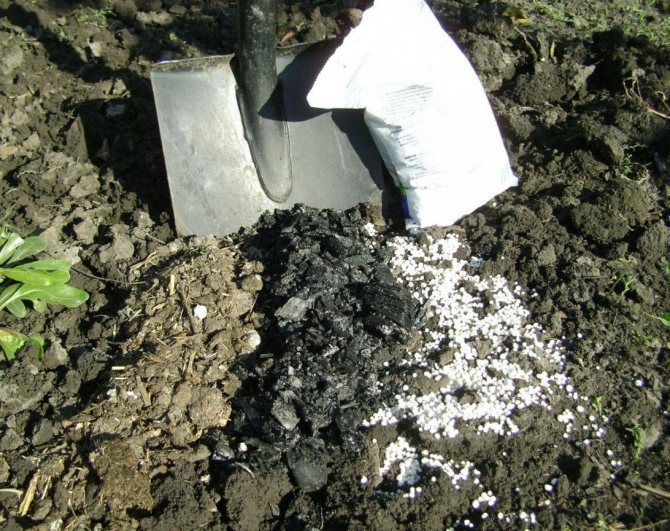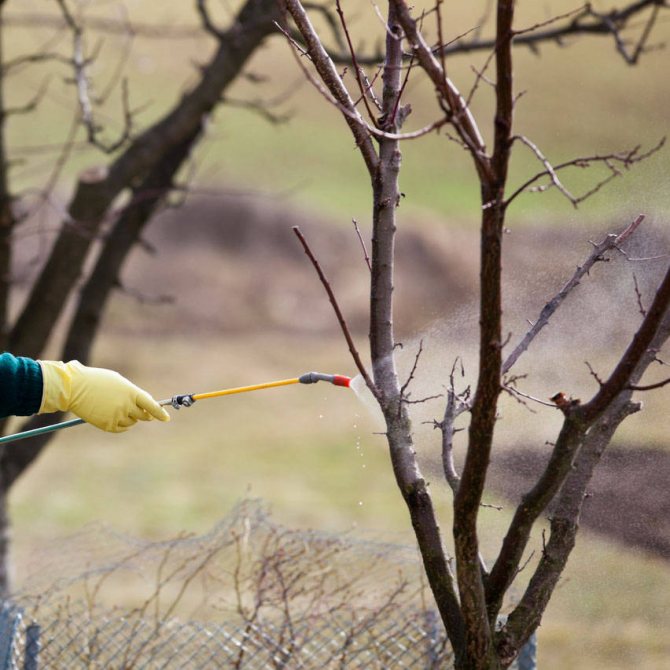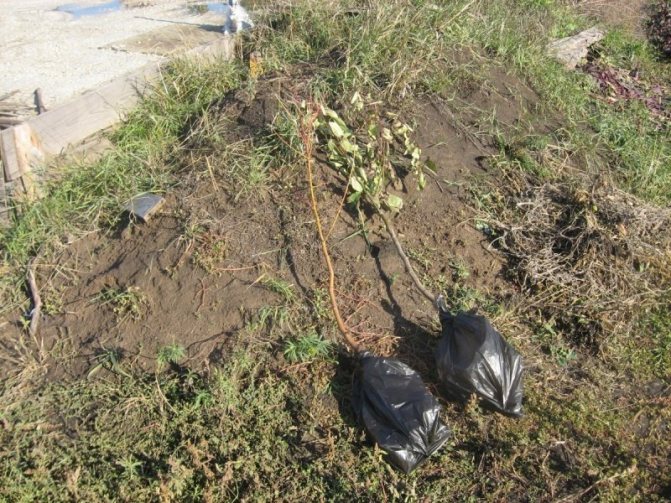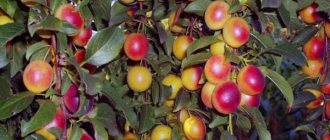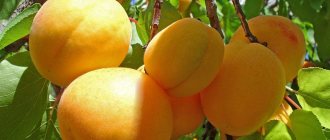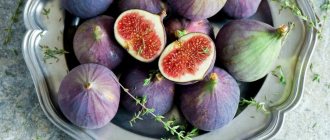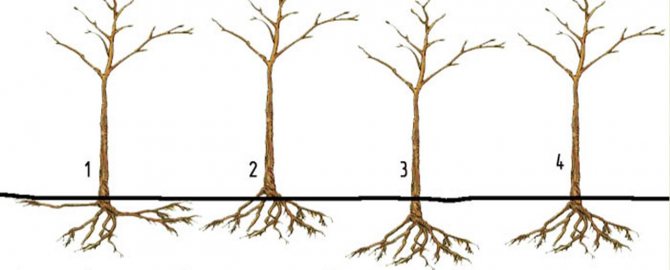
The pear as a fruit and ornamental tree has been cultivated in the world for a long time. So, in Ancient Greece, they began to grow it more than 1,000 years ago. Currently, this crop is planted in spring and autumn, however, it is believed that the autumn period is more preferable. To plant a pear correctly in the fall, you need to learn all the subtleties and advantages of this process.
Advantages of autumn planting of pears in the Moscow region and the region
It is often much easier to plant a pear in the Moscow region in the fall than in the spring months. There are many reasons for this:
- In the autumn, there is always a larger selection of planting material. And it is usually of better quality. Nurseries try to present a wide range of seedlings in markets and shops. The demand for pear seedlings in autumn is quite high, the goods are not stale on the shelves. Less likely to acquire a tree with damaged or dried out roots. Cool weather also contributes to this.
- Spring is a hot season for gardeners in the Moscow region. For all the worries, it's easy to miss the pear planting dates. And they are pretty short.
- A young tree that did not have time to take root in April-May may suffer from hot and dry weather or from late return frosts. In the autumn, when the growing season of the pear ends, adverse natural phenomena are not afraid of it. Just like most pests.
- In autumn, there is enough moisture in the Moscow region, and warm weather often lasts until November.
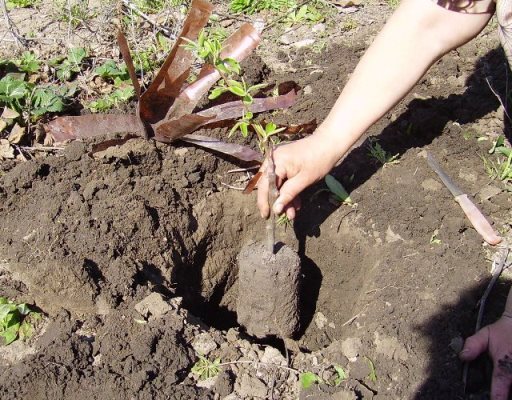

The upcoming wintering, which frightens inexperienced gardeners, in the opinion of most land owners, will only benefit the pear. Planted in the Moscow region in the fall, the plants are well hardened and receive high immunity against a number of diseases. Including fungal nature.
Planting procedure
Planting technology is the same for all fruit trees. So, knowing how to plant an apple or cherry tree correctly, it will not be difficult for a gardener to plant a pear in the fall. The main requirement is to act carefully and follow the sequence of stages.
Step-by-step instruction:
- A small mound is formed at the bottom of the pit, which is watered abundantly. The height of the embankment should be such that the root collar of the seedling standing on it is 3 - 5 cm above ground level.
- Drive a support peg into the ground next to the embankment.
- The seedling is set in a pit, very carefully spreading the roots along the slopes of a bulk hillock. Another person may need help at this stage. One will hold the tree by the trunk, making sure that it stands exactly upright, and the other will carry out all the necessary manipulations.
- Cover the roots of the plant with soil. In the process, you can gently shake it a couple of times so that there are no voids between the roots.
- Fill the entire hole with earth, tamp it slightly.
- Tie the trunk of the seedling to the peg with a strip of soft cloth.
- Form a shallow hole around the trunk to retain moisture.
- Water the seedling generously (you need 2-3 buckets of water).
- Mulch the ground within the trunk circle. Peat or sawdust can be used as mulch.
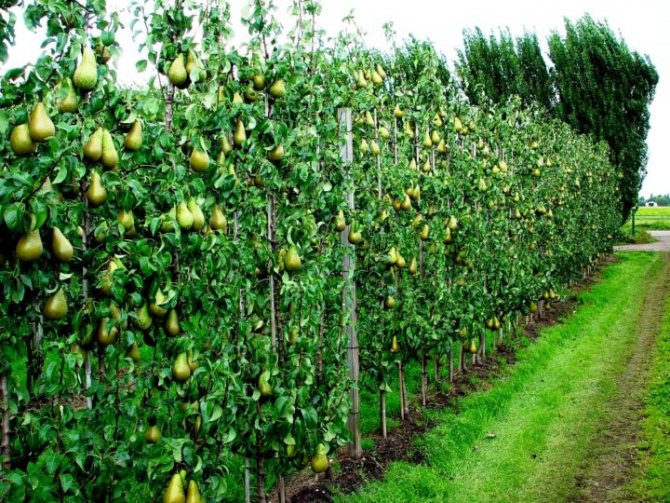

Pear Alley
Subject to this algorithm and provided that high-quality seedlings are selected for planting, the pear will quickly take root.
What kind of pear can be planted in the fall in the suburbs
Pear varieties for the Moscow region are chosen not only for yield, marketable and taste characteristics, but also for ripening periods. Preference is given to early and mid-season varieties, the fruiting period of which is in August and the first half of September.
Summer varieties Lada, Kosmicheskaya, Chizhovskaya have proven themselves well among gardeners. Among the autumn varieties, the high-yielding varieties Mramornaya, Moskvichka, Otradnenskaya are noted.
Attention!
Now there are many late, winter varieties for the Moscow region with high frost resistance. However, they do not always have time to catch up in the unpredictable weather conditions of the middle lane.
How to care for a pear after planting
After completing the event, a gardener, especially a beginner, may have a completely logical question - how to care for a pear after planting? Before talking in detail about the main points of care, I would like to note that the tree in a new place in the garden for the first year will be vulnerable and defenseless, so regular procedures cannot be neglected.
Here are some measures for caring for a pear seedling after planting in open ground, you should definitely follow:
- Fix the seedling to the peg... Gently tie the tree to the peg using a soft string. It is recommended to tie the seedling with a figure eight.
- To water... It is recommended to make a small furrow around the trunk circle in order to irrigate by introducing water into this groove. The optimal amount of water for irrigation is three buckets per square meter of the trunk circle.
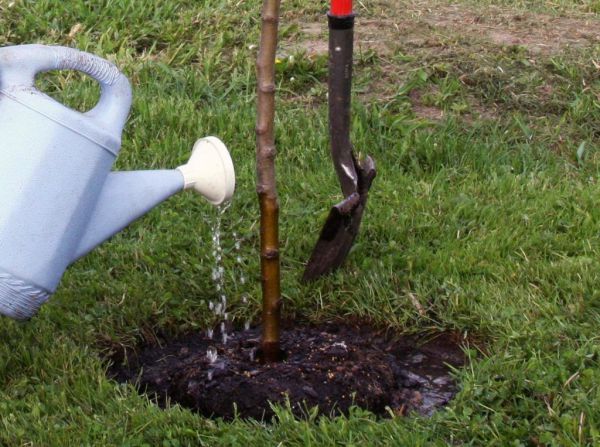

- Mulch. Protection of the trunk circle with mulching material is an important point in tree care after planting in open ground. But mulching is important not only after the procedure, it is also necessary to do it in the fall, before the winter cold. You can use peat, humus, wood chips. The mulch layer is about 20 centimeters.
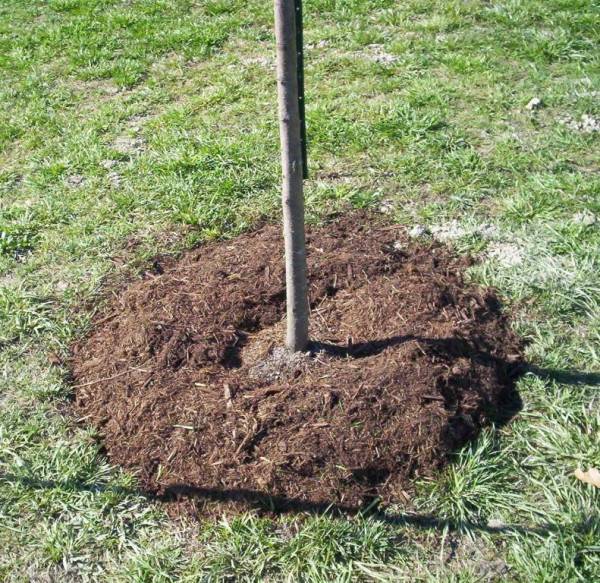

- Loosening and removing weeds... Weeds can easily encroach on your young tree, so you need to keep an eye on it regularly and remove weeds if they appear. And the loosening of the trunk circle should be done after watering.
- Shelter for the winter... The root system of the pear and the tree itself in harsh winter conditions can freeze, so it is important to make shelter in the fall, this is especially true if the pear was planted in the fall. To begin with, wrap the trunk and the bases of the skeletal branches with material - spunbond or burlap, fix the material so that it does not disperse, exposing the trunk. It is recommended to put spruce branches on top of the material and fix it with something. Video: sheltering a pear for the winter:
- Protect from rodents in the fall... Many gardeners can note with bitterness that their garden becomes the territory of a feast of various rodents (hares, mice) in winter. To prevent them from chewing on the trunk of the pear, it is recommended that you wrap it in a cut plastic bottle.
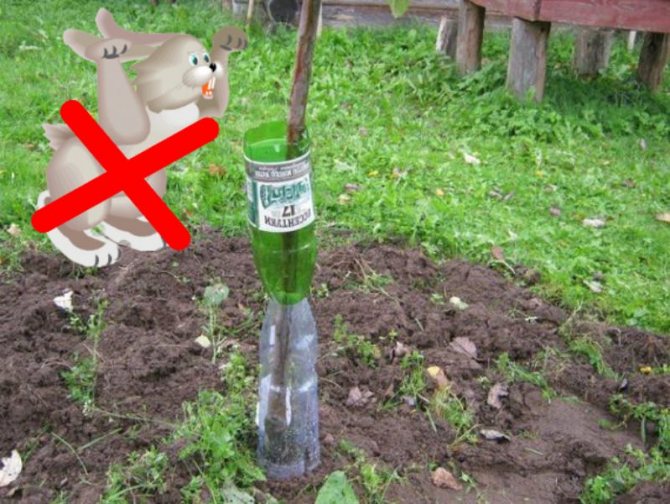

- Trim... After planting, you need to cut the pear seedling - shorten the main stem at the level of 90 centimeters. You also need to produce and trim the side shoots by 20 centimeters. Every year it is necessary to form a pear so that the crown is of the correct shape (optimally sparse-tiered crown) and there are no thickening senseless shoots. Video: pear formation in the second year after planting.
The technology of correct planting of a pear seedling in spring and autumn is easy to execute, even a novice gardener can do the event. But despite the absence of any complex rules, it is important to plant a tree in open ground according to the recommended scheme, following all the rules and stages.
When can you plant pears in the fall in the suburbs
The timing of planting pears in the fall in the Moscow region falls on the first half of autumn. It should be borne in mind that it takes about a month for the tree to fully root.This means that at least 4 weeks should pass from the moment the seedling is planted in open ground until the onset of cold weather with stable subzero temperatures.
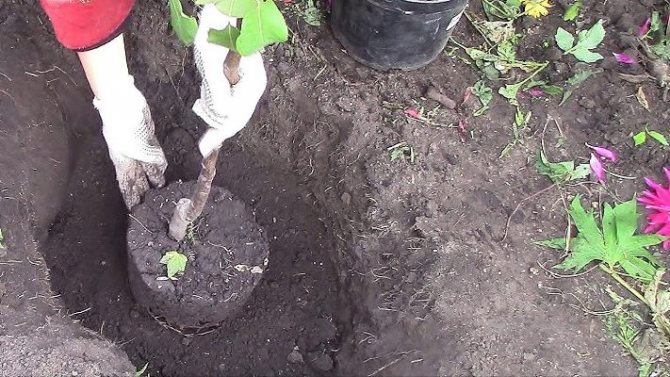

In most cases, pears in the Moscow region are planted from mid-September to mid-October.
Planting dates for seedlings
Saplings of fruit crops were always planted in spring or autumn. Before asking the question: how to plant a pear, you need to answer the question of when to plant a pear.
In Soviet times, the digging of seedlings of fruit trees began in October, after leaf fall. By this time, the growth of the plant stopped, it was completely ready for wintering and was in the phase of hardening and entering winter dormancy.
Dates of autumn planting are very short - only 2 weeks. The tree should ripen to the cold weather to grow additional, supporting roots, germinate in the soil. It is necessary to plant a pear in autumn in Moscow and nearby regions from October 10 to 15.
Important! At a temperature of +5 degrees, planting seedlings with bare roots is undesirable: they can be beaten by frost, which nullifies a successful planting.
Winter-hardy pear varieties that tolerate frost well are planted in autumn.
Insufficiently cold-resistant varieties of pears, as well as stone fruits: cherries, apricots, peaches, plums, sweet cherries, which are mainly southern crops, are planted in most cases in spring.
If the seedling was bought late, in November, then it is best to just dig it in the garden before the onset of suitable conditions.
In the spring, a mandatory formation of the crown of a pear planted in autumn is carried out. The roots of the seedling have not yet had time to germinate in the ground and cannot fully supply the plant with sufficient nutrition.
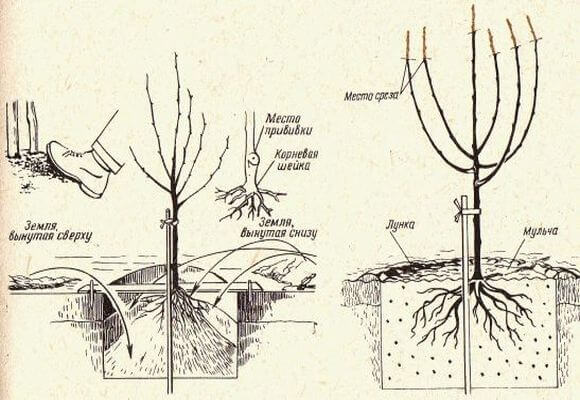

Therefore, strong branches are cut in half of the growth. Weak branches are cut off only a third of the length. A branch cut is made above the bud, located on the outside of the branch, so that the branches grow outward and not inward. In the spring, the crown is trimmed immediately after planting.
Important! In the spring, the time for planting is quite short - about 7 days from thawing of the earth to swelling of the buds.
It is necessary to plant a pear in the spring at this time. And also stone fruit crops in central Russia are traditionally planted in the spring.
Currently, summer planting of seedlings with a closed root system, which appeared on the market only a few years ago, is permissible. They are perfectly developed and do not even notice the transplant.
Their main drawback is the high price and the rarity of the offer. Basically, ornamental crops in containers are grown with ZKS (closed root system). There are few fruit and berry plants grown with ZKS. And the more limited the choice of varieties and zoned plants.
They are planted now in winter. Basically, these are large-sized ornamental plants, planted using special equipment. But the price of such plantings is unacceptable for a wide range of gardeners.
For a successful planting, it is important to purchase high-quality seedlings and it is better to do this in nurseries at horticultural institutes. It is advisable to find out on which rootstocks the seedlings are grafted. The value for the correct distance between trees depends on this.
Do not take weak, frail seedlings. The roots must be lively, strong, without outgrowths and sagging. Do not cut off roots unnecessarily, especially small suction roots. Cut off the broken roots near the injury site.
Leave the seedlings in a bucket of water for several hours before planting. It is good to add a substance to the water that helps the pear to survive stress - Zircon Extra, Epin.
How to plant a pear in the fall in the suburbs
For long-term and abundant fruiting, you need not only to choose the right time for planting, but also to comply with some of its conditions.
Seat selection
For a pear, which is supposed to be grown in the Moscow region, the choice of a place for its future growth is very important. Due to the lack of heat and sudden cold snaps, they choose places that are sunny and well protected from northerly and easterly winds. At the same time, it is not recommended to plant pears along the walls of buildings and high hedges. They will shade the landing. An exception is the south side of the buildings.
It is worth remembering that with the correct formation of the skeleton of a pear and its crown, the latter reaches 4-5 m in diameter, and it should have enough free space.
The second point worth paying attention to is maintaining the moisture balance. Pear does not tolerate waterlogging of the root system. The Moscow region is characterized by uneven precipitation during the season and high groundwater levels.


You cannot plant pears in the Moscow region in low and wetlands, as well as on the lower levels of the slopes. They prefer areas with loose chernozem soils, or with light loamy soils. The tree on them will bear fruit well, provided that a sufficient amount of organic fertilizers is applied. If we talk about the acidity of soils, then choose neutral or slightly acidic.
Soil preparation
Preparations for planting pears in the fall begin 7-10 days before the expected date. This is necessary so that the holes have time to settle, and the soil can be tamped down a little.
- At the beginning of the second month of autumn, holes are dug. Their diameter largely depends on the size of the root system of the seedling. Usually 60-90 cm is enough. The depth is 70-100 cm and depends on soil fertility and the proximity of groundwater. If you need to arrange a drainage layer, and make a high pillow from fertile soil, the hole should be deeper.
- In lowlands and places often flooded with melting snow or heavy rains, drainage is laid from fine gravel or broken bricks up to 10 cm high. You can also use a purchased composition of expanded clay.
- The soil removed from the hole is mixed with 1-2 buckets of rotted compost or humus. Add 200 grams of superphosphate, 100 grams of potassium nitrate. Mix everything thoroughly. To make the soil loose, sand, peat or rotted sawdust are added to the composition. Despite the fact that a pear in the Moscow region grows well on weakly acidic soils, highly oxidized ones are treated with wood ash, slaked lime or dolomite flour. Signs of strong oxidation can be detected by eye. The soil on the site becomes greenish, due to growing moss spores. Horsetail predominates among weeds.
- The pits are filled with such a mixture by a third. A peg is driven in, which will further serve as a support for young trees, and left for several days. In dry years, holes prepared in the fall need watering.
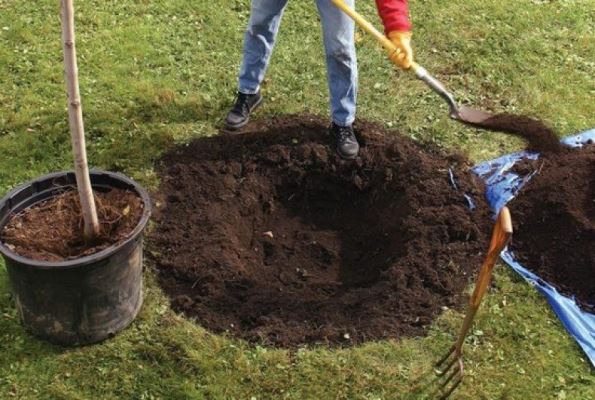

Attention!
The pear, no matter where it will be grown - in the Moscow region or not, has a very delicate root system. It is easy to burn it with the simplest fertilizers. Therefore, when preparing the nutrient mixture, only rotted 2-3-year-old compost is used.
Planting pear seedlings in the fall in the Moscow region
Immediately before planting pear seedlings in the fall in the Moscow region, their root system is carefully examined. Dried, rotten or damaged roots are pruned with a sharp knife or pruner. The seedling is soaked in water for 10-12 hours. It is recommended to add to it any growth stimulant of the Kornevin type in the amount indicated in the instructions.
A mound of prepared soil is poured into the hole so that when planting, the root collar is 4-6 cm above ground level. The seedling is set on a mound, the roots are carefully straightened. The wells are covered in layers, carefully crushing each layer. It is advisable to shake the tree periodically so that the soil fills all the voids.
After planting, a small groove is made around the trunk for watering. The pear is watered abundantly. The root circle is mulched with sawdust, straw or dry peat.Planting of a fruit tree in autumn is completed.


If several seedlings are planted in the fall, then the distance between them is left at least 4-6 m, depending on the variety. Planting seedlings of a columnar pear in the fall in the Moscow region involves planting them at a distance of 1 m from each other.
There are often cases when there is a desire to get a sapling of "that very tasty pear", but the name of the variety is unknown. To plant a pear in the fall in the suburbs in a flower pot, you need a ripe pear, a sharp knife, nutritious soil, pots and a lot of patience. After all, you need to select seeds, soak them in water, remove the skin, grow and plant. A seedling obtained from seeds planted in the fall will be ready for transplanting into open ground in 2-4 years.
Preparatory work
Before planting a seedling, you must complete a number of mandatory activities. These include the choice of a place in the garden, the preparation of planting holes and soil, as well as the purchase of seedlings.
Place for a tree
When choosing a place in the garden, it should be borne in mind that the pear is a thermophilic tree. Therefore, the site must be well protected from cold winds and drafts. Also, young trees need a lot of light, which will help increase photosynthesis and further increase yields. The ideal location would be a slight rise in the south or southeast direction.
How to grow indoor lemon at home
Attention should be paid to the condition of the soil on the site. In too heavy and poor soil, the seedling will develop only for the first time, feeding on a fertile mixture that was introduced into the planting pit. Therefore, cultivated loamy or sandy loam soil is better suited for seedlings. In this case, the fertile layer should be at least 20 cm, and the occurrence of groundwater should be at least 3 m.
Planting pits and soil
Planting pits are prepared in advance (in late spring or summer). During this period, the site is carefully dug up, enriching it with the introduction of compost, superphosphate and potassium salt. For each seedling, holes are dug with a depth of at least 60 cm and 80-100 cm in diameter. The walls are made as vertical as possible, thereby ensuring the correct shrinkage of the soil. During digging, the surface layer of the earth is separated from the lower layer for further use.
Having stepped back a little from the center, gardeners install a stake to which the seedling will be tied.
To fill the pit, a fertile mixture of sand, compost and superphosphate is prepared, and the dug sod soil is also added to it. If the soil is highly acidic, then lime or wood ash is added.
Sapling selection rules
Most gardeners purchase seedlings from nurseries and garden centers. Usually in the fall, young trees are sold with an open root system. Specimens up to two years old have the best survival rate, since at this age they perfectly tolerate digging and transportation. When choosing a pear, pay attention to the following signs:
- The root system of a good tree is necessarily flexible and without obvious damage. The central root should be at least 30 cm long and have 4-5 tines.
- The crown and roots of the seedling must be commensurate. If the crown is well developed, and the root system does not have a sufficient number of shoots, it means that the seedling was dug out in violation of the technology.
- The bark of a young tree should fit snugly against the trunk. There should be no signs of swelling and visible damage on it.
The purchased seedling will need to be planted within 14 days. To prevent the roots from drying out, they are wrapped in damp burlap and paper.
Follow-up care
Pears planted in the fall in the Moscow region do not need additional feeding. Water the seedlings only when necessary. And not at the root, but in a groove dug around the trunk.
For the winter, the root circle is mulched with a layer of 8-10 cm.As a rule, a mixture of peat and sawdust or needles is used. As the snow falls, make additional shelter from it. In the early years, it is important to protect the pear from the attacks of rodents. To do this, the trunk is wrapped in spruce branches, burlap or plastic mesh. Shelters are made as high as possible. In addition to mice, both hares and roe deer love to feast on young pear bark.
Secrets of a successful wintering
Preparation of pears for winter in the suburbs begins with the first cold snap. To do this, the trunk circle is mulched (if it has not been done earlier), and the optimal layer is from five to ten centimeters. In addition, it is necessary to provide shelter for the trunk from frost and protect the bark from rodents. To do this, in the first year of life, tarpaulin, burlap, plastic materials are wound around the trunk or covered with branches of spruce and pine. Later it will be possible to build temporary shelters made of wire, which will reliably protect against rodents. The method of whitewashing the trunk works well, but in especially hungry years this will not stop hares and mice.
Read also: Do-it-yourself cleaning of the Termex water heater
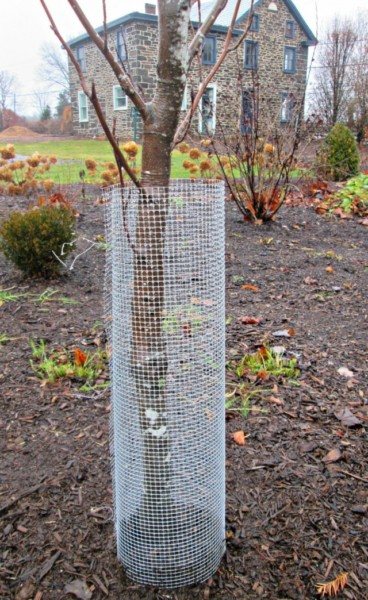

Watering the seedling is gradually reduced, after the snow falls, the near-stem part is estimated with a snowdrift. Pruning pears in the fall is carried out even before the onset of frost, as well as treatment for diseases and pests. During the winter thaw period, the shelter must be removed so that the tree trunk does not become rotten. In snowless winters, it is especially important to insulate the root zone of a seedling planted in autumn in order to avoid freezing. If there is a lot of snow, it can be used as a "pillow".
In the spring, the shelter is removed, inspected and possible damage is repaired. Further care is determined by the characteristics of the variety and the climatic region of growth.
Planting and caring for a pear in the Moscow region has important features, because late-ripening varieties are not suitable for this climatic zone. In addition, it is very important to choose the optimal planting location, as well as the composition of the soil. How to grow a pear correctly, the secrets of planting and further care for the Moscow region and Central Russia - all the necessary information is only with us.
Pear is one of the fruit trees most often grown by Russian gardeners. Few suburban areas do without this tree. Its fruits can not only be consumed fresh, but also used in the preparation of various dishes and winter preparations. In order for a pear to give high yields of varietal quality fruits, it must be properly planted, taking into account all the requirements for growing.
How to shape a tree
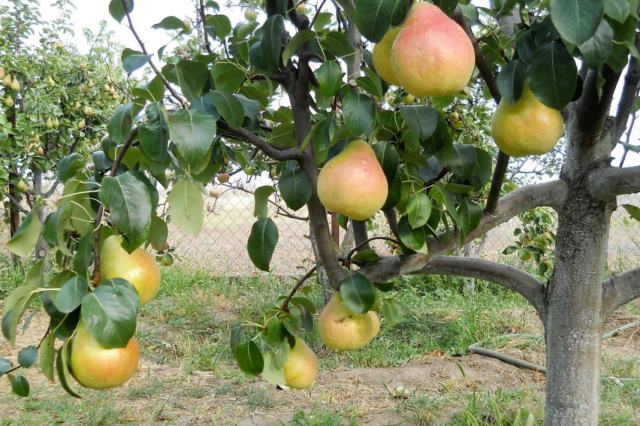

After the harvest has been harvested, the next important thing to do is pruning the pear in the fall. The diagram will simplify the task, but even without it, it is easy to understand the principles of this operation. Of course, it is better to remove excess in spring, before sap flow, for this end March - early April is suitable. But in the fall, you can shorten the branches, the main thing is that they are small. Then the tree will survive the shearing the least painful. And remember that pruning pears in the fall should be gentle.
The diagram will show that in the first year it is necessary to shorten the trunk by cutting off a fourth of it. This will help the formation of a branched crown. Cut off the side shoots quite a bit, you need to remove their ends with a sharp pruner to the first strong bud. The next year, shorten the trunk by 25 cm, and the side shoots by 5-7. Shape the crown so that the lower branches are larger than the upper ones and are at an obtuse angle. In subsequent years, you will remove new branches that are competitors to the old ones, cutting the first ones closer to the trunk, but this operation must be carried out in the spring. Here's how to properly plant a pear in the fall and form a strong tree that will bear fruit abundantly almost every year.
Landing in open ground
After completing the preparatory work and choosing a seedling, gardeners proceed directly to planting.If the roots of a young tree are dry, then it is placed in water for a day. Then the root system is treated in a solution of clay, mullein and water. Experienced gardeners recommend using a step-by-step guide to plant a pear correctly in the fall:
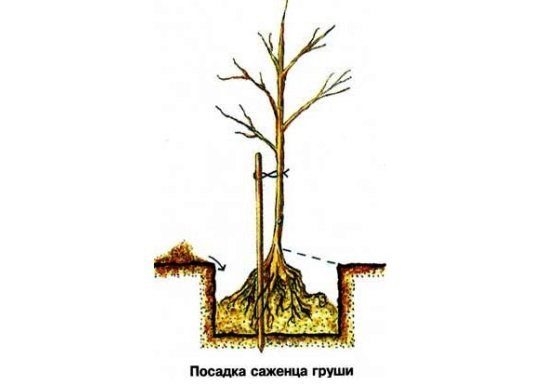

At the bottom of the pit, pour a mound on which the seedling will rest. In this case, you need to ensure that the root collar is 5 cm above the ground level.- A young tree should be planted in relation to the cardinal points in the same way as it grew in a nursery. The bark on the north side of the trunk is lighter than on the south.
- Having exposed the seedling correctly, it is covered with a prepared fertile mixture. To fill the voids evenly, the seedling is shaken periodically.
- The soil is lightly tamped, and the tree is tied to a peg with a soft rope.
- The seedling is watered abundantly using 20-30 liters of warm and settled water.
- On top of the trunk, mulch is poured from peat or sawdust.
In the future, the plantings are cared for and prepared for the winter period. A properly planted tree will easily endure the winter cold and meet the spring healthy and strong.




